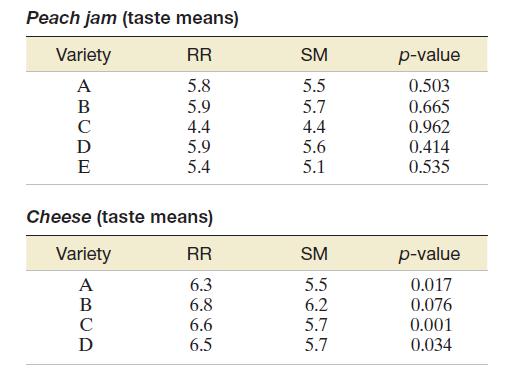Comparing taste test rating protocols. Taste testers of new food products are presented with several competing food
Question:
Comparing taste test rating protocols. Taste testers of new food products are presented with several competing food samples and asked to rate the taste of each on a 9-point scale
(where 1 = “dislike extremely” and 9 = “like extremely”).
In the Journal of Sensory Studies (June 2014), food scientists compared two different taste testing protocols. The sequential monadic (SM) method presented the samples one at a time to the taster in a random order, while the rank rating (RR) method presented the samples to the taster all at once side by side. In one experiment, 108 consumers of peach jam were asked to taste-test five different varieties.
Half the testers used the SM protocol, and half used the RR protocol during testing. In a second experiment, 108 consumers of cheese were asked to taste-test four different varieties. Again, half the testers used the SM protocol, and half used the RR protocol during testing. For each product
(peach jam and cheese), the mean taste scores of the two protocols (SM and RR) were compared. The results are shown in the accompanying tables.
a. Consider the five varieties of peach jam. Identify the varieties for which you can conclude that “the mean taste scores of the two protocols (SM and RR) differ significantly at a = .05.”
b. Consider the four varieties of cheese. Identify the varieties for which you can conclude that “the mean taste scores of the two protocols (SM and RR) differ significantly at a = .05.”
c. Explain why the taste test scores do not need to be normally distributed in order for the inferences, parts a and
b, to be valid.
Step by Step Answer:

Statistics Plus New Mylab Statistics With Pearson Etext Access Card Package
ISBN: 978-0134090436
13th Edition
Authors: James Mcclave ,Terry Sincich





